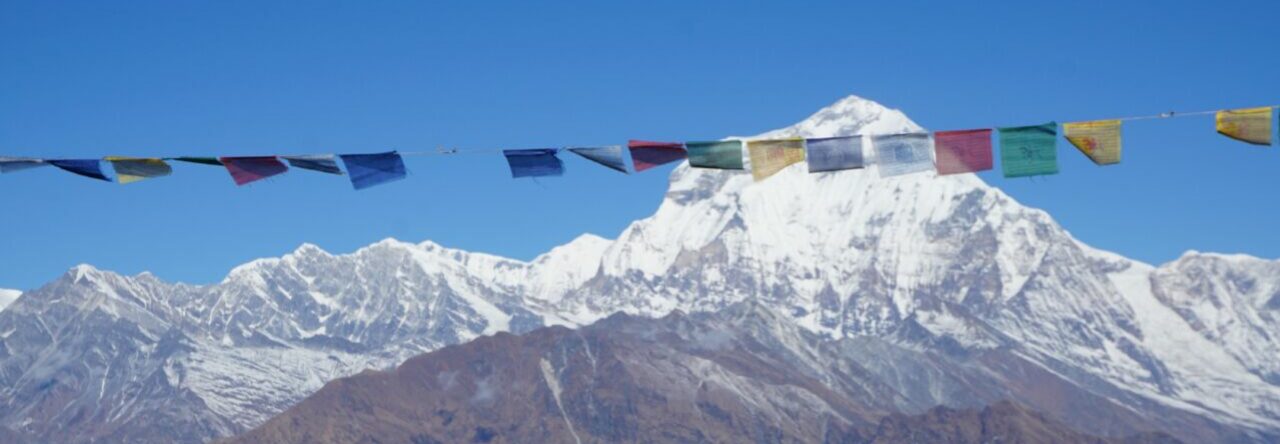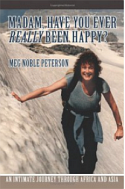December 11 – 12, 2018
We savored every step of our descent from Lareni to Paudwar, noticing a definite change in the terrain as we went through one vegetative zone after another. There were pine, alder, ferns, rhododendron, and bamboo again. It was even getting warm enough for some young ferns to start unfurling.
As we descended there were many lush gardens with cauliflower, sugar cane, beans, corn, mustard greens, garlic, cabbage, carrots, and white radishes (daikons).
Click on photo to see slideshow.
Entering Paudwar, we passed people sitting on their slate courtyards threshing beans (the livestock eats the shells or pods), drying barley, buckwheat, and amaranth (a kind of grain), washing clothes, digging out a new foundation on the side of a hill, and going about their daily activities. There were women, children, and babies everywhere.
This was like an ancient medieval town—small alleyways, slate-roofed houses, everything made out of stone, narrow, perilous streets, turning and winding. This is what they mean by “watch your step!”
You can imagine how disconcerting it was for me to see teenage girls in flip flops sailing ahead of me as if they were taking a walk in the park. It was, however, the most picturesque village I’d ever seen in Nepal.
We wandered up and down, finally arriving at the Barahee Guest House.
It had only one drawback…the toilet was outside and locked, and we were inside and on the second floor. Rather inconvenient! But the room was comfortable, the view excellent, and the temperature so much warmer than the last few days.
During the afternoon we walked around town, enjoying interacting with the locals. We happened by a school and enjoyed watching a group of girls playing a strenuous game of volleyball. What fun! We sat on the stone “bleachers” and cheered them on.
Here is a slideshow of village life and the people there.
After the best dinner so far…steamed cauliflower, assorted veggies with butter and an excellent fried veggie roll, we were invited to watch a popular game, kabaddi, on TV. It’s the national sport of Bangladesh, and also very popular in Nepal and India. This was the first time I’d seen this unusual game. I really don’t know how the players survived! Looked like about 8 or 9 men with no helmets, only knee pads. Individual players took turns crossing onto the other team’s side, repeating “kabaddi, kabaddi” (or an alternate chant) for 30 seconds, while the opposing team tried to tackle him and prevent him from invading their territory. Points were scored by tagging as many opponents as possible without taking a breath or being caught.
The next day we took off through the village to start another four-hour downhill to Tatopani, famous for its hot springs. It would be our last stop before Pokara. I had done another section of the Annapurna circuit in 1999 before there were roads, and I found the woodland trails far more beautiful than the dusty, unfinished road. Also, the spectacular views of Mt. Machupuchare and Dhaulagiri were far more prominent from our forest camps. But I also understood why the Nepali villagers wanted better access to markets, medical help, and other needed supplies. Too bad for the tourists…much better for the locals. Their life may have looked quaint to us, but they, too, wanted modern conveniences and a better life.
As we wended our way down the alleys and walkways, we marveled at the intricate juxtaposition of houses, seemingly all attached at different levels and built with the same gray stone. The slate roofs were lovely in the morning sun as well as the numerous courtyards. I can’t imagine what would have happened to the village if the earthquake of 2015 had hit them. Nothing had been built with any precautions or safety measures.
We alternated between going down a rather new road (even ‘though there was one place that had almost been obliterated by a landslide), and old paths or short cuts to save time. These were very steep and perilous, but much more interesting than the road!

 Fortunately, there were many chautari where we could sit and have a snack and water. And I presciently ordered four hard boiled eggs and oranges at breakfast that we used to assuage our hunger and supplement the ever-ready power bars during the long descent.
Fortunately, there were many chautari where we could sit and have a snack and water. And I presciently ordered four hard boiled eggs and oranges at breakfast that we used to assuage our hunger and supplement the ever-ready power bars during the long descent.
Once, again, we noticed a distinct change in ecosystems. There were gorgeous long-needle pines mixed with bamboo, some in clusters and others standing tall by themselves. We came upon a large grove of oranges and bananas, and a field of brilliant poinsettias.
On the mundane level we saw numerous minor mishaps between various earth-moving machines trying to complete the road, and it was hilarious. Even saw mechanics, who came in on motorcycles and worked frantically to repair the machines that were clogging the road. And an hour later we saw the disabled vehicles, having magically turned around, heading out of the area.
Looking down the road into the deep valley we saw several bridges leading to locations like Jomson and Poon Hill, both places I’d been in the past. I hadn’t realized how closely the towns were connected in this region until we reached Pokara and saw the same range of mountains from another vantage point. Those were places I trekked with my friend, Jon Pollack, in 1999. Ah, what memories!
At the end of four hours, we had reached a very long bridge that spanned a roiling river and hooked up with the final section of road we would walk to Tatopani.
 How happy we were to be ushered into our large room with attached bath (en suite in the Himalayas no less!), which overlooked a lush garden. We immediately unzipped our long climbing pants to make shorts, and donned a T-shirt, then walked five minutes to the famous hot springs, from which Tatopani gets its name.
How happy we were to be ushered into our large room with attached bath (en suite in the Himalayas no less!), which overlooked a lush garden. We immediately unzipped our long climbing pants to make shorts, and donned a T-shirt, then walked five minutes to the famous hot springs, from which Tatopani gets its name.
We sat in almost-boiling water for as long as we could stand it, and enjoyed chatting with an international crowd of all ages: Aussie, Indian, Nepali, Japanese, English, Dutch, South Korea, Russian, New Zealand…but no other Americans. For the last few days we’d made no mention of Trump (always an unfavorable response, and queries as to how he could have been elected), and it was a great relief to leave him behind.
 Dinner was wonderful…my first non-veg meal since I left home. Garlic ginger chicken with great gravy and, of course, the wonderful cauliflower and carrots that abound in Asia. We went to bed knowing that the real trek was over and the next day would be spent navigating a bumpy road under construction that would rival Mongolia. But that, too, would be part of the adventure.
Dinner was wonderful…my first non-veg meal since I left home. Garlic ginger chicken with great gravy and, of course, the wonderful cauliflower and carrots that abound in Asia. We went to bed knowing that the real trek was over and the next day would be spent navigating a bumpy road under construction that would rival Mongolia. But that, too, would be part of the adventure.
I was at peace as I thought about these last nine days. And I thanked my lucky stars (and God, too) for Cary. She is an amazing, sure-footed climber. She seldom makes a mistake, and is calm and reliable. And she helps me keep a steady pace, especially on uphills, by singing a soothing Tara mantra. It borders on the hypnotic. I feel very confident being with her. And very, very happy.














































jerene
Transfixed, as usual Meg with your wonderful sharing of landscape, beautiful people, and fine adventures. With your delightful interpretation of such a different culture, my desire to return to Nepal is quickened afresh! Thank you thank you thank you!!
Nolan Nancy
Wonderful and Facsinatinng photos and details, Meg! Oh, how I would love to hear Cary’s Tara mantra. It would be as soothing here on island walks close to home.
Sandie Miller
Beautiful! When did you actually do this trip?
Susan Edwards
I agree! This was another beautiful sharing of your experiences. Once again, I felt as though I was traveling with you – just like I felt reading your book. And the photos and videos are wonderful!
Lynn Rubright
So savor your adventures . And lingered on the pictures… especially fascinated by the handcrafted stones that were part of each building and the skill of the stone masons and builders. Beautifully made and functionality designed. And then the great variety of steps and walkways. The rich patterns of horizontal and vertical elevations. Powerful aesthetic. Huge play space for great volley ball game. And community gatherings. So rich. Thanks Meg for creating this travelogue. Humbly watched in awe. Lynn